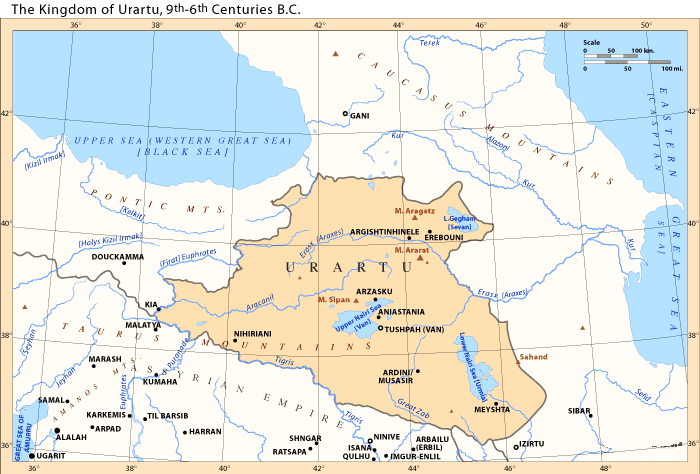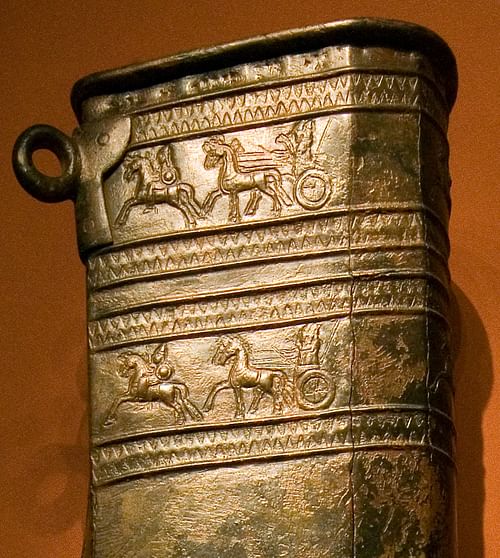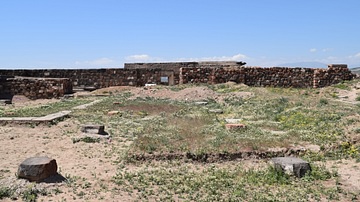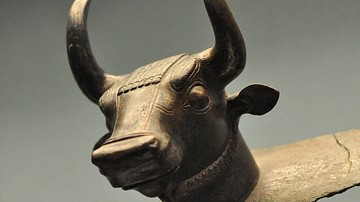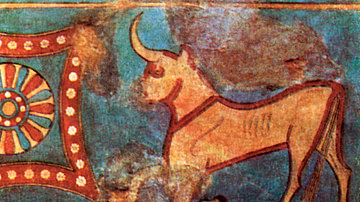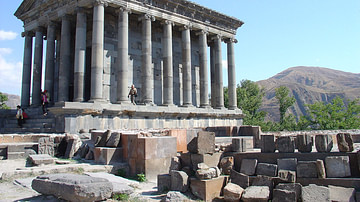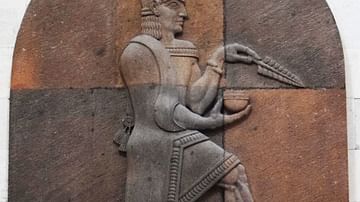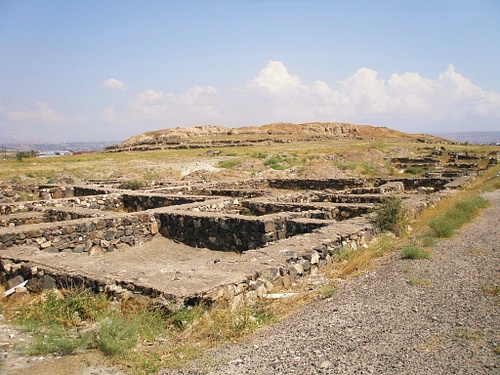
Teishebaini (aka Tesebaini, modern Karmir-Blur, near Yerevan, Armenia) was an important fortress city of the Urartu civilization and excavations at the site, largely undisturbed since its abandonment c. 590 BCE, have provided an invaluable insight into the daily life of the region during the Bronze and Iron age of the 9th to 6th century BCE. With huge walls, large storerooms, granaries, wine and beer vats, along with many specialised workshops packed with artefacts, Teishebaini was a thriving production centre and focal point of Urartian wealth and military power.
Foundation & History
The Urartu civilization flourished between the 9th and early 6th century BCE in ancient Armenia, eastern Turkey, and northwestern Iran. The fortress city of Teishebaini, located on the Ararat Plain, was founded by king Rusa II (r. c. 685-645 BCE) and was named after Teisheba, the Urartian god of storms and thunder. Today the site is called Karmir-Blur, and it is located near the current capital of Armenia, Yerevan.
The city, a regional capital and seat of a viceroy, primarily functioned as an important fortress which helped maintain the rule of the Urartian kings over their empire. Inscriptions attest to the frequent visits by the king and the religious sacrifices that then had to be made in his honour. Artefacts of varying dates and carrying dedicatory inscriptions naming different kings suggest that such precious goods had been transferred from other Urartian sites once Teishebaini had been completed. The sheer volume of the site's food storage capacity, much larger than needed for its own residents, indicates that Teishebaini was also an important administrative and economic centre in the region.
Finds of three-pronged arrowheads, typical of Scythian archers, found at the destroyed site of Teishebaini are suggestive. The destruction of the city first by military attack and then by fire sometime between 594 and 590 BCE seems to have been unexpected, with granaries recently filled and weapons and precious belongings seemingly abandoned in a hurry. The territories the Urartu kingdom had once occupied were ultimately taken over by the Medes from c. 585 BCE onwards and then incorporated into the Achaemenian Empire by Cyrus the Great in the mid-6th century BCE. Some Urartian cities continued to be inhabited into later times but Teishebaini was definitively abandoned in the early 6th century BCE.
Archaeological Excavations
Discovery
Teishebaini was only rediscovered in 1939 CE when Russian and Armenian archaeologists successfully followed a trail of artefacts and inscriptions which pointed to a settlement on a large mound in the outskirts of Yerevan. Handily, for the purposes of identification, a bronze belt and a ringed bolt were both inscribed in cuneiform with, “Rusa Argishtihini, fortress of the city of Teishebaini”. With both of these objects being portable, and so possibly from another fortress site, confirmation would have to wait until a doorway and a section of wall were excavated with matching inscriptions. The mound did indeed contain the ruins of Teishebaini. Once found, archaeologists struggled to know exactly where to begin in their excavations, but chance was to provide a helping hand, as the chief archaeologist Boris Piotrovsky explains:
…work was brought to a standstill by heavy rain; and on the following morning the whole layout of the fortress was visible on the ground. The walls of adobe brick retained the water longer than the earth filling and showed up clearly as darker outlines on the ground. (136)
The site was revealed to cover an area of 400,000 square metres (100 acres), with the royal palace alone boasting 120 rooms and an area of 40,000 square metres. There were workshops, storerooms, wine cellars, granaries, housing and courtyards. Remains of the lower courses and foundations of the fortress' towers survive and are formed of very large basalt blocks. The towers were square and the walls buttressed at intervals. The walls were up to 3.5 metres (12 feet) thick in places and possibly up to 7 metres high. The wall facing the river had several square projections outwards, and the whole complex was built in a stepped arrangement over the various levels and contours of the natural citadel. Access to the interior of the fortress was provided by means of a ramp on the south-western side, a massive South Gate and a postern gate in the north-west corner (it was this gate which bore the brunt of the attack which destroyed the city).
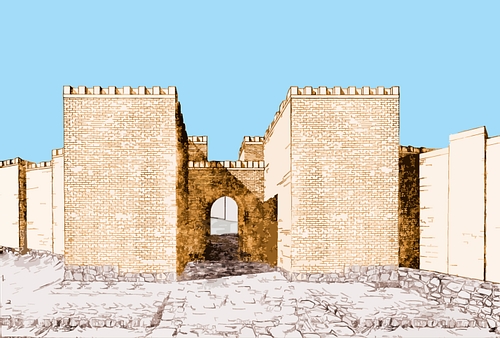
Some roofs of the buildings were made of wooden beams (e.g. pine, poplar or beech) and supported by wooden columns while others had barrel-vaulted roofs made from large adobe bricks. Doorways were made from thick wooden planks and fastened by means of a hinged bronze latch. The settlement was provided with fresh water via a canal running from the Ildaruni River and which went through a tunnel made into the basalt walls of the fortress.
There were private homes of various sizes and with a differing number of rooms, indicating they belonged to different social classes. Some buildings had two or three stories, and all were laid out in a regular plan suggesting that Teishebaini was purpose-built for a population who moved in upon completion.
The Storage Rooms
Once the walls were excavated and a general plan ascertained, excavations began to go deeper into the site. Piotrovsky here describes his impression when one storeroom first saw daylight again:
There was an atmosphere of desolation in the palace. There were wasps's nests and skeletons of mice, and in one of the jars the skeletons of a mouse and a cat were found. The cat it seems chased the mouse into the jar and both found themselves trapped because of its depth. When the the dust of centuries had been removed, the warehouses gave the impression of having only recently been occupied. Jars full of corn, bowls, lamps of clay, iron knives - all tidily laid out. And no one had lived there for over 2500 years. (quoted in Chahin, 101)
Many of the large storage jars of Teishebaini were sunk into the floors of the storerooms. With each jar inscribed with its contents in cuneiform, they had an impressive combined capacity of 150,000 litres (40,000 gallons). These jars, often still containing organic remains, were used to store wheat, barley, millet, grapes, oil and sesame. Six wine stores had a capacity of 34,000 litres (9,000 gallons). Beer was brewed from barley which was fermented in large vats covered with straw and branches and then stored in elongated and round-bottomed jars.
Yet another room was dedicated to the production of sesame oil and included a large tufa vat in which the seeds were first soaked before pressing. Finds of large churns with fitted wedges indicate that cheese and butter were also made.
One room at the fortress contained the neck and breast parts of 26 cattle. Another room was filled with the burned remains of young animals with their heads and extremities missing. Both of these rooms indicate the extent of animal sacrifice in the Urartu religion. Meanwhile, whole skeletons of cattle, horses, asses, and sheep found elsewhere show that animal husbandry was carried out on a significant scale at the site. One record lists precisely the manufacture of by-products such as wool and skins.
Workshops seem to have been dedicated to specific materials, one, for example, contained only stag horns and iron saws, another had loom weights, spindles, and a carbonised roll of cloth. Outside the citadel, there were workshops dedicated to pottery and metalwork. All of the stored and manufactured goods at the site were meticulously accounted for on inscribed clay tablets. In addition, many of the storerooms had their doors sealed with a knotted rope covered in clay and impressed with two official seals.
Artefacts
As a testimony to Teishebaini and Urartu's position as an important regional trading centre, many artefacts have been discovered at the site which are of foreign origin. These include Assyrian cylinder seals, a faience amulet from Egypt inscribed with hieroglyphics, a faience vessel typical of those from Rhodes, Scythian horse-bits, and gold jewellery from Asia Minor.
Regarding Urartian artefacts, a huge quantity of bronze and iron weapons have been excavated at Teishebaini, and they include swords, daggers, arrows, spears, helmets, shields, and quivers, many often incised with decorative scenes, especially of lions and bulls. There were statues of gods; a fish-man and a scorpion-man figurines; bronze cauldrons with ornate three-dimensional decorations around the rim; and large quantities of red polished pottery (especially jugs), with rarer examples of black pottery. One unusual form of Urartian pottery is the vessel made in the shape of a boot, complete with painted stitching and laces. Several examples have been excavated from Teishebaini, and they date to the 8th century BCE. Jewellery finds include bronze fibulas, sardonyx and carnelian beads, silver medallions, and gold bracelets, earrings, and necklaces. There were 87 bronze cups neatly stacked in one room, many inscribed with a king's name and an emblem of a fortified tower and a tree. Finally, there is a fine ivory statue and another figurine in bronze of Teisheba, the god who gave his name to this remarkable fortress site.
This article was made possible with generous support from the National Association for Armenian Studies and Research and the Knights of Vartan Fund for Armenian Studies.
